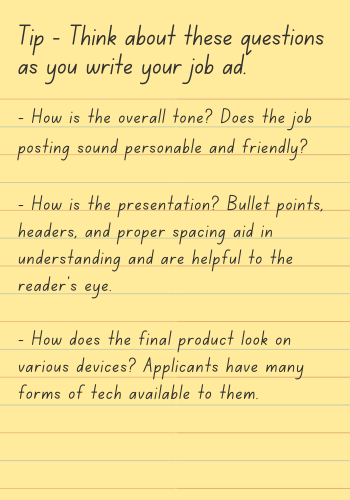Recommendations for writing job descriptions to attract good talent
 Finding your next outstanding new hire starts with writing an effective job description that yields a pool of promising top talent. In today’s competitive climate, a good job description can be the difference between your ideal candidate applying for the position or passing it over completely. Job seekers need to be able to find your job opportunity among the multitude out there and be convinced the role suits their background and desires.
Finding your next outstanding new hire starts with writing an effective job description that yields a pool of promising top talent. In today’s competitive climate, a good job description can be the difference between your ideal candidate applying for the position or passing it over completely. Job seekers need to be able to find your job opportunity among the multitude out there and be convinced the role suits their background and desires.
Unsure what constitutes a great job ad that gets results? Here is a look at writing job description best practices.
Construct the job title carefully
Employers may think coming up with a unique job title will help their company stand out from the crowd. The problem, though, is that using a non-standard title increases the odds that the right candidates never see the job listing. Job seekers search on terms such as “marketing specialist” or “marketing associate,” not on “marketing ninja” or “marketing rockstar.” Save the creativity for elsewhere in the job description, and stick with an SEO-friendly job title.
Present the basics immediately
Individuals browsing through job postings want to know right away whether or not continuing to read on is in their best interest. No sense wasting time if the job is located in a faraway city or is only part-time when desiring full-time. Thus, employers should present the job title, where the position is based, and its type (full-time, part-time, permanent, temporary, contract) clearly from the get-go.
Nowadays, smart companies also quickly address the issue of off-site work. Use words such as “remote,” “virtual,” “distributed” or “work at home” to convey when a job can be done from anywhere. If the job has a hybrid arrangement (some time in the office) or requires enough proximity to the office to come in on certain occasions, spell that out.
Determine the “must-haves”
To get everything you want, you need to ask for it, right? Not exactly. A laundry list of prerequisites has the potential to scare away a large number of applicants, especially females. Research shows that men apply for a job when they meet only 60% of the qualifications, but women apply only if they meet 100% of them.
Remedy the situation by focusing on what the new hire truly needs for the position. What competencies must someone absolutely possess to perform essential job duties? Common criteria include a certain educational attainment or degree, a license or certification, mastery of industry-specific software or procedures, and previous experience performing specific skills. Avoid labeling anything as “mandatory” unless it truly is non-negotiable.
Watch, too, that you don’t overdo the required years of experience. While the position may demand someone with a track record of success, putting an exact numerical value can deter applicants. Is there really a magic number of years of experience? Consider offering a range or rewording to seek applicants with a “solid work history” rather than a specific length of time logged.
After figuring out the core requirements, hiring managers likely have in mind remaining qualifications that would be wonderful for an applicant to possess. Consider including the ones you feel most strongly about in a separate paragraph or section as “preferred qualifications,” “desirable attributes,” “good to have,” or “bonus points for candidates possessing X, Y, and Z.”
When discussing the skills for which you are looking, aim for clarity. Acronyms and internal jargon can confuse readers. Stick with standard, industry-appropriate terms. Language such as “entry-level” or “senior staff” works better than classifications such as “Level II” or “Pay grade IV.”
Convey what the open role entails
Just because someone deems himself qualified for the role does not mean he wants to take it. Candidates yearn to know what they will be doing each day, who they will report to, and how their position fits into the company’s overall objectives. They want to get excited about the job and feel like they could make a true difference.
A great job description enables a qualified applicant to envision herself in the open position. She can imagine performing the list of responsibilities and interacting with other team members.
Employing terms such as “you” and “we” instead of speaking in the third person (i.e., “the applicant” or “the company”) adds an element of personalization that promotes forming a connection. Draw the prospective new hire in with phrases such as “Your expertise on ABC will lead us to achieving better XYZ” or “You’ll make your mark by overseeing our projects involving QRS.”
Using action verbs helps with visualization and creates more energy around what the job entails. Some strong verbs to consider for job descriptions include:

Advise
-
Interpret
-
Investigate
-
Compile
-
Arrange
-
Confer
-
Coordinate
-
Initiate
-
Recommend
-
Verify
Describe what is in it for them
Compensation, of course, ranks high among things potential candidates want to know. Providing a salary range enables applicants to judge whether or not the two of you have a chance of being on the same page.
Be sure to tout benefits, too. An excellent health plan, generous PTO, assistance in paying off student debt, on-site yoga classes, or even pet insurance can be perks that nudge a candidate in your direction.
People also like to know that a potential employer takes an interest in their future. Mentioning opportunities for training and development attracts individuals looking not only for a job now but for a chance to grow their career path.
However, be sure not to over-inflate these offerings. Overpromising and under-delivering is a sure way to lose a promising candidate down the road.
Remember the importance of company culture
Many job opportunities post similar qualifications, duties, and pay. Distinguishing your organization from the pack often comes down to your work environment and culture fit. What is different about you and your employer brand? What makes your company a great place at which to work? How is your company’s mission helping customers and the world at large? Millennial workers especially find such information critical to job decisions. They want to connect with those with whom they work, feel a sense of belonging, and contribute to the big picture.
As your company aims to distinguish itself from others, consider putting in some interesting tidbits. Has your organization won any industry or community awards? Does your business support certain causes or perform volunteer work as a group? Do any fun facts stand out in your company’s history? Present what makes you memorable.
With many candidates concerned about diversity, job ads frequently contain an EEO (Equal Employment Opportunity) statement. Many employers, though, go beyond letting candidates know that all applicants receive equal treatment. These companies actively encourage applications from underrepresented groups such as women, minorities, and people with disabilities. The job posting also may note specific organizational efforts to create a diverse workforce and a welcoming work environment.
Additional best practices when writing job descriptions
When a job opening arises, employers oftentimes are tempted to dust off the open role’s previous job description or settle for something “close enough.” However, failure to evaluate if what you are putting out there truly grasps what you’re looking for and is written in a way that will draw in the top talent you desire can lead to a sparser or less desirable candidate pool. Job analysis is worth the time as it enables you to craft an effective job description.
Things to think about as you perfect your job ad include:
-
How is the overall tone? Does the job posting sound personable and friendly?
-
How is the presentation? Bullet points, headers, and proper spacing aid in understanding and are helpful to the reader’s eye.
-
How does the final product look on various devices? Applicants have many forms of tech available to them, and they do not have patience for jumbled, confusing layouts.
Finally, answer the question “Are we being honest?” While your company wants to present itself in the best light possible, fabrication ultimately helps nobody. If the new hire will be expected to travel twice a month, she should know that from the get-go rather than have it sprung on her after accepting the position. Likewise, do not tout a wonderfully stocked breakroom if all you are offering is a pot of coffee and a package of Oreos. Remember, you don’t want to be back to square one of the hiring process for this position because the person you selected feels deceived.






